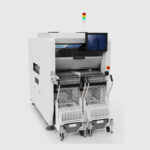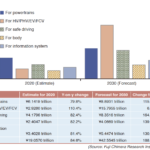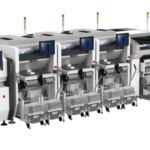ASIA ELECTRONICS INDUSTRYYOUR WINDOW TO SMART MANUFACTURING
JUKI Expands Business in Non-SMT Region
As part of efforts to expand its business in the non-mounting region, JUKI Corporation released in Dec. 2021 the SE1000 visual inspection machine. This signals the company’s full scale entry into the visual inspection business.
SE1000 detects defects and measures dimensions of metal components for automobiles and other products.
Ventures into Non-SMT Business
JUKI also focuses on the expansion of solutions for automated warehouses and inspection systems in non-mounter/non-surface-mount technology (SMT) areas. The company now reaps the fruits of its efforts in this field.
As part of this venture, JUKI acquired in February 2020 an equity stake in XTIA Ltd. The company commercialized the optical comb technology, which was given Nobel Prize. JUKI aims to achieve technological innovation in visual inspection machines under a technical tie-up with XTIA.

High-Precision Inspection in Metal Components
At present, at automobile factories and machine factories, manual visual inspection or machine-exclusive visual inspection for respective components are being carried out.
The SE1000 visual inspection machine enables high-speed, high-precision inspection of defects in metal components. It contributes to deskilling, labor saving and higher efficiency of the inspection process in the production of automobiles and related products, which conventionally requires manpower.
CMOS Camera with High Frame Rate
The new inspection machine achieves high-precision inspection with excellent general-purpose properties. It is equipped with a high frame rate CMOS camera with 12 million pixels, which applies JUKI’s propriety optical technology. This CMOS camera combines with the high brightness white three stage LED light and coaxial light to capture sharp images. SE1000 can inspect various components up to 600(W)×50(D)×300(H)mm with high inspection precision of 12µm on a single unit.
Users can select between two-dimensional (2D) or three-dimensional (3D) inspection depending on the application of inspection. The high frame rate CMOS camera with 12 million pixels and the use of high-speed arithmetic circuit realize high-speed inspection. 2D inspection takes 0.25 second per field of view (FOV), while 3D inspection takes 0.7 second per FOV.
High Rigidity Frame
Cast metal is adopted for the frame, which forms the base of the equipment. High rigidity frame achieved through frame design technologies, including computer aided engineering (CAE), modal analysis, and servo characteristics analysis, realizes high-speed operation of optical head unit.
In addition, the technology to correct XY axes positions, lighting illuminance, white balance, and resolution among machines, maintains high repetition accuracy of equipment. This eliminates variations among individual machines.
Management Software
In cases where more than one machine is installed in multiple bases in different parts of the world, the same inspection program can unify management. It can capture images with optimum focus, realizing high-precision visual inspection. An optional vertically variable head unit, with which the height of the camera automatically changes in accordance to the height of object to be inspected, enables this function. Adding the optional laser measurement enables detailed inspections, for example, of the depth of scratches.
Two methods – template and process modes – used for the creation of programs are available. The template mode enables even a beginner to easily create programs.
JUKI Smart Solutions
JUKI promotes JUKI Smart Solutions in its industrial equipment business. The JUKI Smart Solutions achieve highly efficient production of SMT lines in the global market. It includes machines on the mounting line, including automated guided vehicles (AGVs). These machines are then linked to its own products, such as solder paste printers, printed circuit board (PCB) inspection systems and automated warehouses, aside from mounters.
The JUKI Group integrally operates the whole supply chain, including the development of hardware and software, such as lighting, camera, and calculating software. JUKI’s support system for quality assurance and maintenance at its bases around the world, allows the use of its machines with confidence.




